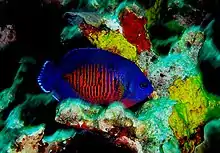Twospined angelfish
The twospined angelfish (Centropyge bispinosa), also known as the dusky angelfish, or coral beauty, is a species of marine ray-finned fish, a marine angelfish belonging to the family Pomacanthidae. They are found in the Indo-Pacific.
| Twospined angelfish | |
|---|---|
 | |
| Scientific classification | |
| Domain: | Eukaryota |
| Kingdom: | Animalia |
| Phylum: | Chordata |
| Class: | Actinopterygii |
| Order: | Perciformes |
| Family: | Pomacanthidae |
| Genus: | Centropyge |
| Species: | C. bispinosa |
| Binomial name | |
| Centropyge bispinosa (Günther, 1860) | |
| Synonyms[2] | |
| |
Description
The twospined angelfish has a basic dark purplish-blue body. This is marked with irregular orange vertical bars on its flanks. The dorsal, caudal and anal fins have a bright blue margin.[3] The dorsal fin contains 14 spines and 17-18 soft rays while the anal fin has 3 spines and 17-19 soft rays. This species attains a maximum total length of 10 centimetres (3.9 in).[2]
Distribution
The twospined angelfish is found in the Indo-Pacific. Its range extends from the coast of East Africa between Tanzania and South Africa as Far East as the Tuamotu Islands of French Polynesia, north to the Izu Islands of Japan and south to Lord Howe Island.[1] In Australia, as well as Lord Howe Island, it is found from the Rowley Shoals and Scott Reef in Western Australia, Ashmore Reef in the Timor Sea, and along the east coast from Raine Island in Queensland to Bass Point in New South Wales as well as Christmas Island. Offshore it occurs at Norfolk Island, Elizabeth Reef and Middleton Reef in the Tasman Sea and Ashmore Reef and Kenn Reef in the Coral Sea.[3]
Habitat and biology
The twospined angelfish is found at depths of 5 to 50 metres (16 to 164 ft) in coral reefs within lagoons, rubble patches and drop offs, being commonest around drop offs.[1] They live in small social groups consisting of a single male and a few females. They are protogynous hermaphrodites and the most dominant of the females in a group will change sex to become male if the existing male dies or disappears.[3] This species feeds on algae and detritus.[4]
Systematics
The twospined angelfish was first formally described in 1869 by the German-born British ichthyologist and herpetologist Albert Günther (1830-1914) with the type locality given as Ambon Island, Indonesia.[5] In some classifications it is placed in the subgenus Centropyge.[6]
References
- Pyle, R.; Myers, R.F. (2010). "Centropyge bispinosa". IUCN Red List of Threatened Species. 2010: e.T165871A6153518. doi:10.2305/IUCN.UK.2010-4.RLTS.T165871A6153518.en. Retrieved 20 November 2021.
- Froese, Rainer; Pauly, Daniel (eds.) (2019). "Centropyge bispinosa" in FishBase. December 2019 version.
- Dianne J. Bray. "Centropyge bispinosa". Fishes of Australia. Museums Victoria. Retrieved 18 Jan 2021.
- "Centropyge bispinosa". Saltcorner!. Bob Goemans. 2012. Retrieved 18 January 2021.
- Eschmeyer, William N.; Fricke, Ron & van der Laan, Richard (eds.). "Species in the genus Centropyge". Catalog of Fishes. California Academy of Sciences. Retrieved 18 January 2021.
- Christopher Scharpf & Kenneth J. Lazara (21 July 2020). "Order ACANTHURIFORMES (part 1): Families LOBOTIDAE, POMACANTHIDAE, DREPANEIDAE and CHAETODONTIDAE". The ETYFish Project Fish Name Etymology Database. Christopher Scharpf and Kenneth J. Lazara. Retrieved 18 January 2021.
- "Centropyge bispinosa". Integrated Taxonomic Information System. Retrieved 6 June 2006.
- Froese, Rainer; Pauly, Daniel (eds.) (2006). "Centropyge bispinosa" in FishBase. May 2006 version.
External links
- Centropyge.net info page
- Photos of Twospined angelfish on Sealife Collection
